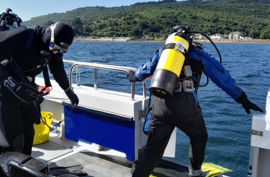Addressing the growing threat of PFAS (or 'forever chemicals') in the UK
Published: 11 December 2023
By Bill Atkinson, Chief Scientific Advisor
In recent years, the pervasive use of per- and polyfluoroalkyl substances (PFAS) has emerged as a significant environmental and public health concern.
The World Health Organisation has just reclassified one such compound – PFOA – that was widely used in non-stick pan coatings and firefighting foams – as a known carcinogen.
As Chief Scientific Advisor and head of the company's pollutant advisory group, it's my role to be aware of these emerging issues and to advise and assist our clients in meeting the challenges that these issues may pose to them. This ranges from an increased understanding of the complexities surrounding PFAS and the risks that they pose, to taking proactive steps to combat this growing threat.
Understanding PFAS: a persistent menace
PFAS are a group of many thousands of man-made organofluoride compounds consisting of multiple fluorine atoms attached to a carbon chain (which is attracted to oil) and with a 'head' that is attracted to water. It is this combination of attraction (and repulsion) to both oil and water, as well as their chemical stability, that makes PFAS compounds ideal for their many applications. They do not metabolise or break down into much simpler compounds very easily, and under typical soil conditions, it can take over 1,000 years for some PFAS to degrade. It is hence why they are known as 'forever chemicals'.
It is because they do not break down in the environment naturally that leads to PFAS contaminating soils and drinking water as they migrate through both. It has been recently reported that PFAS has been detected in 17 of England's 18 water companies.
The persistent build-up of PFAS in the environment then leads to PFAS entering the local wildlife and aquatic life, which then moves up the food chain (a process called bioaccumulation) and can potentially lead to human contamination through consumption of contaminated food.
Why phase-out is not making the problem go away
As more data has emerged on their persistence and toxicity, some 'longer chain' PFAS compounds like perfluorooctanoic acid (PFOA) and perfluorooctane sulfonate (PFOS) have been subject to global regulations restricting or banning their use.
They have been typically substituted with shorter-chain alternatives, but this has given rise to new concerns.
Short-chain PFAS may have lower performance, leading to increased quantities being used and emitted. Their widespread use intensifies environmental and human exposure, possibly perpetuating the issues posed by their long-chain counterparts. In addition, the longer-term toxicity of the vast majority of these newer alternatives is still largely unknown. They may also be more difficult to remove using existing technologies.
One of the most significant challenges posed by PFAS is their persistence in the environment. Even with a halt in their release, PFAS will persist for generations, necessitating ongoing efforts to address contamination and its far-reaching effects. The socioeconomic costs of PFAS contamination, including irreversible damage to natural resources, are considerable and difficult to quantify (one NGO even estimates the societal cost as high as €16 trillion per year).
Regulatory frameworks and future initiatives
The concerns about PFAS are leading to several increasing restrictions or proposed changes. The European Chemicals Agency (ECHA) published its EU REACH restrictions for PFAS in February 2023. This proposal aims to place limits on more than 10,000 per- and polyfluoroalkyl substances.
In the US, the EPA have been developing their definition of PFAS and, in October 2023, they released a final rule that eliminated an exemption that allowed facilities to avoid reporting information on PFAS when those chemicals were used in small concentrations.
In 2022, the UK Drinking Water Inspectorate published an updated information letter and guidance for PFAS compounds in drinking water, requiring water companies in England and Wales to monitor for a wider range of PFAS and update their risk assessments accordingly. The DWI guidance follows a tiered approach with a guideline value of 0.1 micrograms per litre, which is equivalent to 0.1 parts per billion. However, dedicated legislation - or even guidance - on soil quality is lacking.
Our commitment and innovations
We are at the forefront of tackling PFAS-related challenges, working with our clients to implement solutions that are innovative in terms of how existing technology like the use of granular activated carbon (GAC), reverse osmosis, and ionic exchange is applied, or takes in newer and more innovative processes like flocculation.
One such recent and ongoing project won the Innovation of the Year category at the prestigious UK & Ireland Spill Association Annual Awards 2023.
Our commitment extends to research and innovation activities focused on analytical methods, alternative substances and technologies and remediation of contaminated soil and water.
A call to collaborate and innovate
The PFAS issue reinforces our commitment to effective environmental stewardship. Collaboration between industries, governments, and research communities is imperative. Together, we can drive innovation, develop sustainable practices, and address the multifaceted challenges posed by PFAS.
The journey to a PFAS-free future starts with increased awareness of the problem. This hopefully leads to collective action. We are committed to creating better environmental outcomes for our clients and society in general. This includes tackling the PFAS issue, so that together, we can safeguard our environment, protect public health, and build a more resilient and sustainable future for all.
More from our Knowledge Hub
 News
NewsDemystifying the new biodiversity net gain legislation
 Case study
Case studyBlue carbon habitat suitability assessments in Scotland as part of Carbon Neutral Islands project
 Insights
InsightsChanges to ESOS reporting system and compliance notification deadline extended to 6 August 2024
 Insights
InsightsEverything you need to know about ESOS phase 3
Keep your business compliant and protect the environment while reducing the risk of operational downtime
Find out how Adler and Allan reduce your risk and support you on your journey to Net-Zero through the management and maintenance of assets.
Contact our experts

